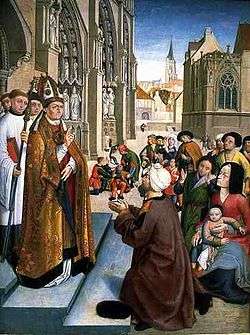Latro of Laon
| Saint Latro | |
|---|---|
|
Saint Remigius. Painting by Master of Saint Giles. It has been theorized that the 4 figures in the right foreground are Genebald, his wife, and their children Latro and Vulpecula.[1] | |
| Bishop | |
| Born |
~499 AD Laon, France |
| Died | 570 AD |
| Venerated in | Roman Catholic Church |
Saint Latro (literally “Thief”) (French: Latron, Larron) (~499 AD—570 AD) was a Frankish bishop of Laon. He succeeded his father Saint Genebald as bishop of Laon.[2] According to The Golden Legend, Genebald was married to Remigius' niece.[3]
Because the diocese of Rheims was too large, Remigius had decided to create a separate diocese centered at Laon, and chose Latro’s father Genebald to be Laon’s first bishop. A married clerk, Genebald left his wife to become bishop around 499 AD.[3] However, according to Canon Flodoard’s 10th-century account, Flodoardi Historiae Remensis Ecclesiae, and repeated by The Golden Legend,[4] Genebald, after he became bishop, slept with his wife, who became pregnant with a boy.
Genebald asked that his son be named Latro (“Thief”), “because he had engendered it by theft.”[3] So that it would not appear that his wife had borne a child out of wedlock, Genebald had her visit him again. Again they slept together, and this time his wife became pregnant with a girl, whom they named Vulpecula (“she-fox”).[3]
Remigius had Genebald shut in a small cell near the church of St. Julian[2] for seven years. Remigius fed Genebald on only bread and water during this time, and took over Genebald’s duties as bishop of Laon. Genebald was released after seven years, and the bishop of Rheims reinstated Latro's father as bishop of Laon.[3]
According to Christian Cochini, “this legendary narrative probably has a kernel of truth.”[4]
Reinstated as bishop, Genebald remained chaste for the rest of his life. After his death in 550 AD, Latro succeeded him as bishop of Laon.[3] Latro was also venerated as a saint.[3]
References
- ↑ John Oliver Hand, Martha Wolff, Early Netherlandish painting (National Gallery of Art (U.S.) (Cambridge University Press, 1986), 166.
- 1 2 "St. Genebaldus". Heiligen Lexicon. Retrieved May 12, 2009.
- 1 2 3 4 5 6 7 "The Golden Legend: The Life of Saint Remigius". Catholic Forum. n.d. Archived from the original on July 9, 2008. Retrieved May 12, 2009.
- 1 2 Christian Cochini, Apostolic Origins of Priestly Celibacy (Ignatius Press, 1990), 111.
